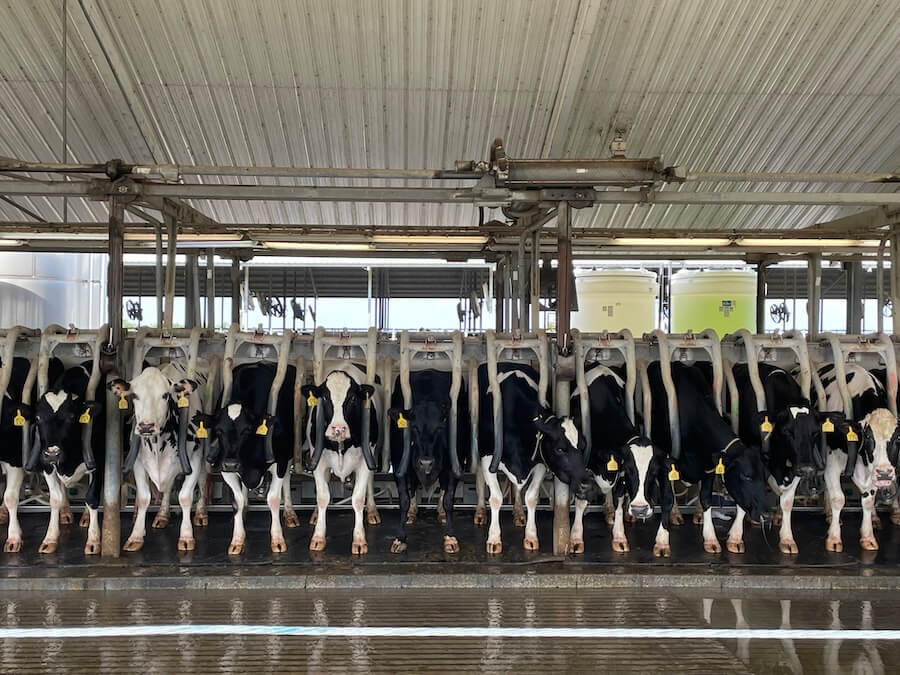Do you avoid talking to clients about heat stress? Are you aware of the issues heat stress cause, but you do not want it to seem like you are passing the buck on your nutrition? How can you talk to clients about heat stress without getting overheated yourself?
Heat stress is real, and cows feel heat stress sooner than we do. A dairy cow’s digestive process produces a lot of heat that they need to dissipate to remain thermoneutral. A cow’s thermoneutral zone is about 68 on the Temperature-Humidity Index (THI), which is a factor of air temperature and humidity. When the environment gets above 68 THI her body will release cortisol and reduce feed intake. This is done on purpose to minimize the heat release of digestion and help her body handle the excess heat load. This is okay for short periods of time, but as it adds up it leads to digestion issues from the reduced intake, and immune and reproduction issues caused by the increased cortisol and decreased nutrient intake, as well as decreased milk yield. These are the real challenges we see each year during hotter months. What can we do to be better? Why is the conversation around improving cow’s ability to withstand heat still difficult?
When I walk into a free-stall barn, I assess fan maintenance: Are the blades clean and unbent? Are all the fans running efficiently without unusual noises? If the farm passes these fan checks, it is usually a good indicator that they do the small things right. This means they are great candidates for further discussions about reducing the heat load on all the cows. However, if these things are lacking then it is a great first step to discuss heat stress and summer cow management.
One of the biggest research findings to come out in the last few years is the effect of not cooling dry cows for the entire dry period. Laporta et al., (2020) followed generations of cows whose dams were either adequately cooled or not during the entire dry period. They found very conclusively, that the daughters and even granddaughters of the inadequately cooled cows were significantly negatively affected by heat stress. Descendants of cows that were not adequately cooled throughout the entire dry period made less milk, were less reproductively efficient, and did not stay in the herd as long as the descendants of cows that were adequately cooled the entire dry period. Even the embryos that were being formed during that time (the granddaughters) were negatively affected by heat stress!
Are the far-off dry cows getting attention during the summer months with adequate cooling, or are they put in a pasture with no barn and forgotten about for a month? The data from this research makes it clear that we should consider improving heat stress management in dry cows.
Utilizing dairy farm records we are able to look back and see if the cooling of the close-up cows was adequate. Health events by week are the easiest metric to show how the heat during the cow’s last week of gestation affected them. The cows that were not adequately cooled during that final week of gestation will typically have higher incidence of health disorders after calving such as retained placenta, metritis, or milk fever because of the reduced intake and immune system stress. Post-hoc analysis of calving date and previous days carried calf can also be used as an indicator of how the cows handled the heat stress.
High stress (especially heat stress) can cause cows to calve sooner than normal for the herd. Summarizing, the previous days carried calf of cows that calved during the hottest weeks of the summer and comparing to cows that calved during cooler weeks can drive home the point that the cows needed some help. We need to set transition cows up to have a robust immune system for calving and the weeks after. She will face a lot of changes and challenges, and her immune system has a lot of work to do. Keeping her cooled to maintain intake and reduce cortisol will set her up for success. Other factors, like dirty water or mycotoxins, will only add stresses especially during heat stress.
Clean, functional fans, adequately cooled dry cows, and post-hoc analysis of transition health events are practical starting points for discussing heat stress. Bringing in new research about the effects of heat on dry cows and their descendants gives an opportunity to influence generations of the herd’s cows. Being aware of environmental pathogens, feed pathogens, and mycotoxins that add further stress to cows during hot weather, and dealing with the challenges accordingly, will help you support the cows you manage through the summer months.
Caroline Knoblock, MSc, – Director of Nutrition, Agrarian Solutions and Larry Roth, Ph.D., PAS – Vice President of Nutrition


